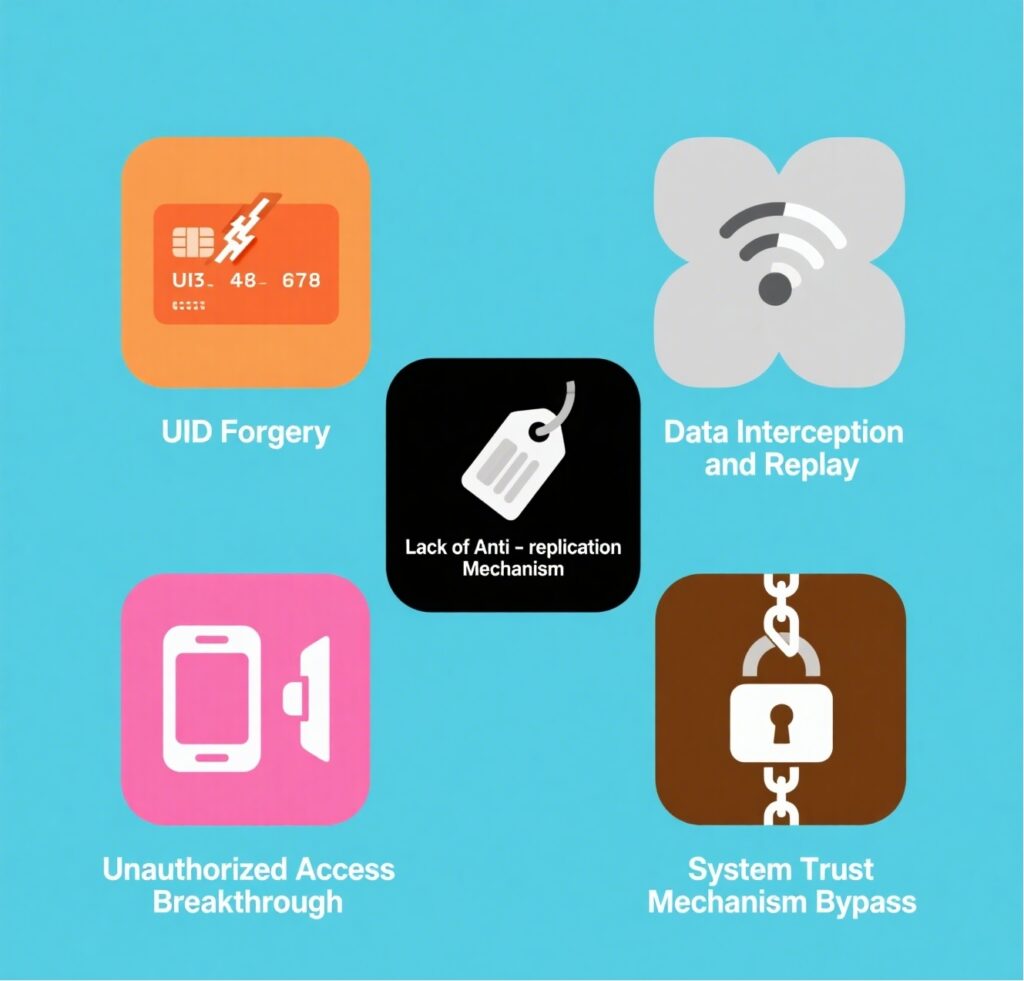Optimizing RFID Reader Module Placement: Expert Tips for Peak Performance
371Struggling with RFID read errors? Learn how to position RFID reader modules for maximum coverage, accuracy, and efficiency in warehouses and retail spaces.
MoreAll RFID Product
In fields such as RFID access control, ticketing, and industrial testing, using Android RFID Emulator—based on Host-based Card Emulation (HCE)—has become key method for rapid deployment and debugging. However, this same technology has also been exploited by malicious actors to spoof UIDs, bypass access permissions, and even clone employee access cards. For system integrators and enterprise IT teams, understanding the security implications of Android RFID emulation and implementing effective protective measures has become critically important.

Since Android 4.4, the system has supported Host-based Card Emulation (HCE), allowing smartphones to emulate RFID tag behavior. The emulation process works as follows:
The RFID reader sends an APDU (Application Protocol Data Unit) command to the phone.
The HCE-enabled app on the phone responds with emulated data.
Developers can define the emulated UID, AID, and card information.
The system remains compatible with readers based on the ISO 14443-4 standard.
As result, smartphones can simulate physical RFID cards and interact with systems without requiring hardware-level authorization under certain conditions.
Despite their convenience, Android RFID emulators introduce several security risks that enterprises must consider:
| Risk Type | Description |
| UID Spoofing | Attackers can forge specific UIDs to bypass authentication systems. |
| Data Interception & Replay | Hackers can intercept communication and replay responses from authorized cards. |
| Unauthorized Access | Emulators can simulate access cards to enter restricted areas. |
| Bypassing System Trust | Systems lacking secondary authentication are easily fooled by emulators. |
| Lack of Anti-Cloning Mechanisms | Tags without dynamic encryption or authentication protocols are easy to duplicate. |

▶ Case 1: Emulating an Employee Access Card
An attacker used an Android phone with an NFC emulation app to clone a coworker’s access card UID. By doing so, they entered the company building at night without triggering access control alerts or logs.
▶ Case 2: Exploiting a Ticketing System Vulnerability
In an NFC ticketing system without encryption or authentication, an attacker captured the communication between a legitimate ticket and the reader. They then emulated the ticket using a smartphone to gain unauthorized re-entry at a live event.
▶ Case 3: Industrial Control System Manipulation
A factory used low-security RFID cards to operate critical machinery. An attacker used an Android RFID Emulator to replicate control commands, which led to unauthorized activation and disruption of automated systems.
| Protection Strategy | Description |
| Use dynamic encrypted cards (e.g., MIFARE DESFire) | Prevent UID spoofing with dynamic challenge-response encryption. |
| Enable anti-emulation detection in readers | Restrict specific device types or detect abnormal antenna characteristics. |
| Implement two-factor authentication (2FA) | Combine card swiping with PIN codes, biometric checks, or facial recognition. |
| Deploy device whitelisting mechanisms | Only allow authorized cards or hardware to interact with the system. |
| Monitor unusual card activity and trigger alerts | Flag suspicious behavior like frequent UID changes or access attempts after hours. |
Using Android RFID Emulator can significantly speed up testing and development, especially during prototyping or access control system upgrades. However, once system moves into production, enterprises must take stricter control by:
Clearly separating emulated devices from authorized production hardware.
Restricting emulator usage by time, role, or network.
Building isolated testing environments to avoid cross-contamination with live systems.
Android RFID Emulator is powerful tool for modern RFID development and system validation, but it also opens potential attack vectors if misused. Enterprises and system integrators must understand its working principles and associated risks. By adopting multi-layer encryption, robust authentication, and access control strategies, they can maintain development agility while building a truly secure RFID infrastructure.

Cykeo CK-BQ6826 Jewelry uhf rfid tag features NXP UCODE 9, 8m read range on metal, and anti-counterfeit security for luxury assets.

Cykeo CK-BQ8554HF HF rfid cards feature FM1108 chip, 100K write cycles, and customizable printing for access control systems.

Cykeo CK-BQ8554UHF uhf rfid card features U9 chip, 100K write cycles, and CR80 size for access control/inventory management.

Cykeo CK-T8D RFID gate access control system features 4-antenna 99.98% accuracy, ISO 18000-6C compliance, and real-time theft prevention for libraries/warehouses. Supports Windows/Android OS.
Struggling with RFID read errors? Learn how to position RFID reader modules for maximum coverage, accuracy, and efficiency in warehouses and retail spaces.
MoreLearn how to safely update firmware on handheld RFID readers like Zebra or Impinj. Follow our detailed guide to avoid errors, improve performance, and enable new features.
MoreCompare handheld and fixed RFID readers for retail stores. Learn the pros, cons, and best use cases for each to optimize inventory accuracy and customer experience.
MoreIn today digital era, businesses are increasingly demanding efficient management and precise data collection. As key technology in the age of the Internet of Things (IoT), RFID tag readers offer transformative benefits across industries through fe...
More